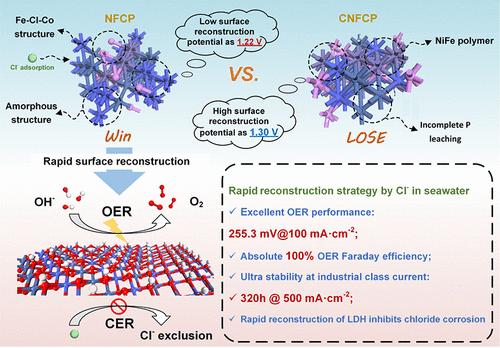腐蚀性 Cl--诱导非晶镍铁钴粉表面快速重构,实现高效海水分离
IF 13.1
1区 化学
Q1 CHEMISTRY, PHYSICAL
引用次数: 0
摘要
受限于海水电解中氧进化反应(OER)的剧烈氧化和腐蚀环境,设计具有高活性和稳定性的催化剂对于提高电解槽的制氢性能至关重要。在此,我们报告了利用海水中的腐蚀性 Cl-,实现非晶镍铁钴磷(NiFeCoP)的快速表面重构,以实现稳定的海水分裂。脉冲电流和 P 的成功引入构建了 Cl- 吸附活性位点,优化了 d 带中心并诱导形成了 NiFeCo(OH)。密度泛函理论计算也验证了镍铁钴(OH)具有令人满意的 OER 活性和排氯特性。得益于电子结构和反应中间体吸附,NiFeCo(OH) 只需要 255.3 mV 的过电位就能达到 100 mA cm-2 的电流密度。同时,所配制的碱性水电解槽(NFCP || Pt/C)在天然海水中以 500 mA-cm-2 的工业电流密度和 1.806 V 的低电压稳定运行了 320 h。总之,这项工作提出了一种用于海洋氢能的高性能海水电催化剂的快速自重构方法。本文章由计算机程序翻译,如有差异,请以英文原文为准。

The Corrosive Cl–-Induced Rapid Surface Reconstruction of Amorphous NiFeCoP Enables Efficient Seawater Splitting
Limited by the violent oxidation and corrosion environment of the oxygen evolution reaction (OER) in seawater electrolysis, the design of catalysts with high activity and stability is crucial for improving the hydrogen production performance of the electrolysis cell. Herein, we report taking advantage of corrosive Cl– in seawater to achieve rapid surface reconstruction of amorphous NiFeCoP for stable seawater splitting. The successful introduction of pulse current and P constructs Cl– adsorption active sites to optimize the d-band center and induce the formation of NiFeCo(OH). Density functional theory calculations also verified that NiFeCo(OH) has satisfactory OER activity and chlorine exclusion properties. Benefiting from the electronic structure and reaction intermediate adsorption, NiFeCo(OH) only requires 255.3 mV overpotential to reach a current density of 100 mA cm–2. Meanwhile, the assigned alkaline water electrolysis cell (NFCP || Pt/C) stably operates for 320 h in natural seawater at an industrial current density of 500 mA·cm–2 with a low voltage of 1.806 V. The seawater AEM electrolyzer (NFCP || Pt/C) achieves an improved performance of high activity (2.095 V@500 mA·cm–2) and stable operation (100 h@500 mA·cm–2) to achieve economic seawater splitting. In summary, this work proposes a fast self-reconstruction of a high-performance seawater electrocatalyst for marine hydrogen energy.
求助全文
通过发布文献求助,成功后即可免费获取论文全文。
去求助
来源期刊

ACS Catalysis
CHEMISTRY, PHYSICAL-
CiteScore
20.80
自引率
6.20%
发文量
1253
审稿时长
1.5 months
期刊介绍:
ACS Catalysis is an esteemed journal that publishes original research in the fields of heterogeneous catalysis, molecular catalysis, and biocatalysis. It offers broad coverage across diverse areas such as life sciences, organometallics and synthesis, photochemistry and electrochemistry, drug discovery and synthesis, materials science, environmental protection, polymer discovery and synthesis, and energy and fuels.
The scope of the journal is to showcase innovative work in various aspects of catalysis. This includes new reactions and novel synthetic approaches utilizing known catalysts, the discovery or modification of new catalysts, elucidation of catalytic mechanisms through cutting-edge investigations, practical enhancements of existing processes, as well as conceptual advances in the field. Contributions to ACS Catalysis can encompass both experimental and theoretical research focused on catalytic molecules, macromolecules, and materials that exhibit catalytic turnover.
 求助内容:
求助内容: 应助结果提醒方式:
应助结果提醒方式:


